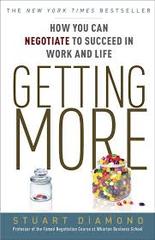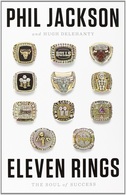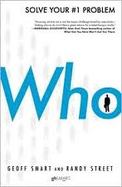 Google's internal negotiation course uses the book Getting More by Stuart Diamond, so I figured it was worth a read. It was alright but definitely not the most useful book on negotiation I've read. I much more prefer the classic Getting to Yes, which was used in Stanford's and UCLA Anderson's negotiation classes. I found Getting More to be way too heavy on anecdotes and stories. This was nice from the perspective of seeing many examples of the techniques in action, but it was overwhelming how many examples there indeed were in comparison to concrete explanation of the techniques and how to learn them. The book claimed at the beginning it would teach a highly disciplined and structured approach to preparing and creating a "List" and using techniques from a wallet card one can download, and I expected that explanation of all this would be the bulk of the book. Instead, this was glossed over in one chapter with barely any low-level explanation, and the rest of the book was devoted to applications throughout all fields of life from parenting to government. Also, I would've loved to read a lot more of the actual dialogues and transcripts of the example negotiations; instead, I read a sample phrase here and there but mostly just how a negotiation was concluded or a problem solved (instead of the full gory details of how the negotiator got there, which is what I would've preferred). All that criticism aside, I did get some very useful bits of information from the book. I liked the emphasis on and many examples of trading items of unequal value and seeing the pictures in other people's heads. These two concepts seem very powerful. Below are my full notes. I think the book was a nice complement to more structured negotiation reading and courses, but I don't think it's enough of a standalone guide to serve as a first book or introduction to the subject.
7 Comments
 I just finished reading my first basketball leadership book: Eleven Rings: The Soul of Success by Phil Jackson. I heard about the book (unsurprisingly) from Ryan Holiday who recommended it and even wrote up its main lessons ("The Jackson Eleven"). I obviously had heard of Phil and knew how successful of a coach he had been, but I didn't realize that his strategies were so grounded in mindfulness, zen, and team trust principles. It was incredible to read the behind the scenes stories of how he transformed the Bulls and the Lakers into repeat champions using similar concepts. I liked how he approached the sport from an intellectual standpoint and integrated multiple principles of psychology to help his team grow. I enjoyed reading about his thinking process when he had to deal with difficult team dynamics or game situations. I liked his generally Stoic approach and the way he led by teaching and getting out of the way. I also like how he gave books to read to the players each year and even asked for book reports! I definitely enjoyed this one, and his list of reading recommendations (which I list at the end of my notes below) seems pretty solid too. Upon a friend's recommendation, I read Who: The A Method for Hiring by Geoff Smart and Randy Street. It was a quick, no-nonsense, super-specific book outlining exactly what you need to do hire A players for any team.
What I liked:
Introduction
Screening interview
2. What are you really good at professionally
2. What accomplishments are you most proud of? 3. What were some low points during that job? 4. Who were the people you worked with?
Master tactics 1. Interrupt the candidate
4. Painting a picture
The focused interview: Getting to know more
2. What are your biggest accomplishments in this area in your career? 3. What are your insights into the biggest mistakes and lessons learned in this area?
3. You do 3 interviews of bosses and ask colleagues to do 2 interviews of colleagues/customers and 2 interviews of subordinates Reference interview questions: 1. In what context did you work with candidate? 2. What were their biggest strengths? 3. What were their biggest weaknesses back then? 4. Rate their performance on a 1-10 scale. Why?
5 F's of what candidates care about Fit
1. When you source
3. Between offer and acceptance
Installing the A method in your organization 1. Make people the top priority 2. Follow A method yourself 3. Build support in team 4. Pass clear vision to team based on A players 5. Train team on best practices 6. Remove barriers/policies in way 7. Implement new policies and scorecards including recruiting A players
9. Remove managers who are not on board 10. Celebrate wins and plan for more change Legal cautions 1. Relevance
3. Standardize language used 4. Avoid specific discrimination questions that are illegal |
Archives
June 2024
Categories
All
Subscribe |

 RSS Feed
RSS Feed
